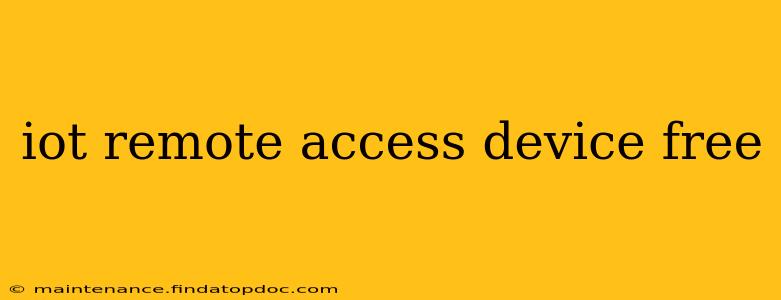The Internet of Things (IoT) offers incredible convenience, allowing us to control devices remotely. However, accessing these devices securely and without recurring costs can be a challenge. This article explores free options for remote access to IoT devices, highlighting their limitations and potential security risks. We'll also address frequently asked questions about securing your IoT devices and choosing the right access method.
What are the Best Free Options for Remote IoT Access?
Unfortunately, truly free and completely secure solutions for remote IoT device access are rare. Most "free" options come with limitations, such as bandwidth restrictions, limited functionality, or security compromises. Many rely on a freemium model, offering basic functionality for free while charging for premium features like increased security or scalability.
Instead of focusing solely on "free," consider the balance between cost, security, and functionality. Let's look at some approaches:
Using a Home Network and Port Forwarding
This method leverages your existing home internet connection. It's technically free but requires technical expertise and careful security configuration. You'll need to:
- Open ports on your router: This allows external access to your device.
- Configure your IoT device: Set its IP address and port settings correctly.
- Use a Dynamic DNS service (optional but recommended): Your public IP address might change; a Dynamic DNS service updates your domain name to match the changing IP, making access consistent.
Security Concerns: Port forwarding increases your vulnerability to attacks if not configured correctly. A misconfigured router or device can expose your network to malware and hacking attempts.
Utilizing Free Cloud Platforms with Limitations
Some cloud platforms offer free tiers for IoT device management. These platforms often restrict the number of devices, data storage, and features available. Examples include:
- Blynk: Offers a free plan but with limitations on the number of devices and features.
- ThingSpeak: Provides a free tier for data logging and visualization but lacks advanced control features.
Security Concerns: While these platforms offer some security features, relying solely on a free tier might not provide sufficient protection, especially for sensitive data.
Employing VPNs with Free Tiers (Proceed with Caution)
Some VPN services have free tiers, but their bandwidth, speed, and security features are often severely limited. Using a VPN to access your IoT devices adds a layer of security by encrypting your connection.
Security Concerns: Free VPNs often have questionable security practices. They might log your activity, throttle your bandwidth, or even inject malware into your system.
How Can I Secure My IoT Devices for Remote Access?
Security is paramount when remotely accessing IoT devices. Consider these steps:
Strong Passwords and Authentication
Use strong, unique passwords for each device and your router. Enable two-factor authentication (2FA) wherever possible.
Regular Software Updates
Keep your router and IoT devices updated with the latest firmware and security patches to address known vulnerabilities.
Firewall Protection
Configure your router's firewall to block unauthorized access attempts.
Network Segmentation
If possible, segment your IoT devices onto a separate network from your other devices to limit the impact of a potential breach.
Encryption
Use encrypted communication protocols (like HTTPS) between your devices and the remote access method.
What are the Risks of Using Free IoT Remote Access Solutions?
The primary risks include:
- Security vulnerabilities: Free solutions often lack robust security features, making your devices susceptible to hacking and data breaches.
- Limited functionality: Free tiers usually restrict the number of devices, features, and data storage.
- Data privacy concerns: Free services might collect and use your data for their own purposes.
- Unreliable performance: Free solutions may experience outages, slow speeds, or other performance issues.
How Much Does a Secure IoT Remote Access Solution Cost?
The cost of a secure solution varies depending on your needs, the number of devices, and the features required. Expect to pay for reliable services offering robust security, scalability, and support.
Is it Safe to Access My IoT Devices Remotely?
Remote access to IoT devices can be safe if you implement proper security measures. However, using free, unsecured solutions significantly increases the risk of compromise.
By carefully weighing the risks and benefits, selecting the appropriate approach, and prioritizing security, you can harness the power of remote IoT access while mitigating potential threats. Remember, a balance between convenience and security is key.
